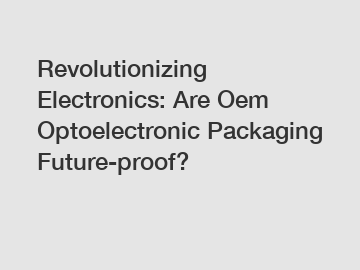Revolutionizing Electronics: Are Oem Optoelectronic Packaging Future-proof?
Revolutionizing Electronics: Are OEM Optoelectronic Packaging Future-proof?
The evolution of electronics is a constantly moving target, with new technologies and innovations emerging at a rapid pace. Optoelectronics, in particular, have seen significant advancements in recent years, leading to more efficient and powerful electronic devices. As original equipment manufacturers (OEMs) grapple with how to best package and protect these sensitive components, the question arises: are OEM optoelectronic packaging solutions future-proof?
Optoelectronic Packaging: The Current Landscape.

Optoelectronic components, such as LEDs, laser diodes, and photodetectors, are becoming increasingly prevalent in a wide range of applications, from consumer electronics to medical devices. The packaging of these components is critical to their performance and reliability, as optoelectronics are highly sensitive to environmental factors such as temperature, moisture, and mechanical stress.
Traditional packaging methods, such as surface-mount technology (SMT) and chip-on-board (COB) packaging, have been widely used for optoelectronic components. However, these methods have limitations in terms of thermal management, optical performance, and long-term reliability. As a result, OEMs are exploring new packaging solutions that can address these challenges and future-proof their products.
Advanced Packaging Technologies for Optoelectronics.
One of the most promising technologies for optoelectronic packaging is integrated chip-on-board (iCOB) technology. iCOB combines the advantages of traditional COB packaging with advanced integration techniques, such as flip-chip bonding and wire bonding, to achieve higher performance and reliability. iCOB also enables the integration of additional components, such as sensors and microcontrollers, into a single package, reducing the overall size and cost of the final product.
Another emerging technology in optoelectronic packaging is wafer-level packaging (WLP). WLP involves packaging the optoelectronic components directly on the wafer before dicing, leading to improved thermal performance, reduced parasitic capacitance, and higher levels of integration. WLP is particularly well-suited for high-volume manufacturing, making it an attractive option for OEMs looking to scale up production.
Future-Proofing Optoelectronic Packaging.
As OEMs continue to push the boundaries of optoelectronic technology, the need for future-proof packaging solutions becomes increasingly important. Future-proofing optoelectronic packaging involves designing packaging solutions that can adapt to changing technology trends, such as higher power densities, increased data rates, and miniaturization.
To future-proof their optoelectronic packaging, OEMs should work closely with their packaging suppliers to leverage the latest materials, design techniques, and manufacturing processes. Collaboration between OEMs and suppliers can help ensure that packaging solutions are optimized for the specific requirements of the optoelectronic components, leading to improved performance, reliability, and cost-effectiveness.
In conclusion, OEM optoelectronic packaging is undergoing a revolution, driven by advancements in technology and the need for future-proof solutions. By embracing new packaging technologies, such as iCOB and WLP, OEMs can stay ahead of the curve and deliver innovative optoelectronic products to the market. As the electronics industry continues to evolve, it is clear that optoelectronic packaging will play a crucial role in shaping the future of electronic devices.
Contact us to learn more about our advanced optoelectronic packaging solutions and how we can help future-proof your electronic products.
Want more information on Optoelectronic Packaging News, Esd Antistatic Blister Tray, Epe Tv Bag? Feel free to contact us.

Comments